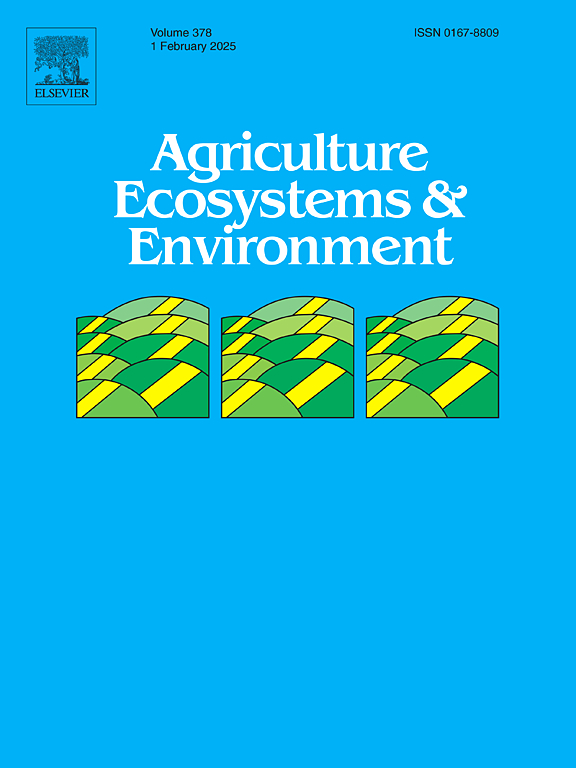Water-saving irrigation can mitigate climate change but entails negative side effects on biodiversity in rice paddy fields
IF 6
1区 农林科学
Q1 AGRICULTURE, MULTIDISCIPLINARY
引用次数: 0
Abstract
Tackling climate change while enhancing biodiversity without compromising production is a main goal in agricultural management. In rice farming, water-saving irrigation techniques alternative to permanent flooding have been globally adopted to face more severe and frequent droughts and have proven effective in reducing greenhouse gas emissions. Yet potential trade-offs with other global concerning environmental issues such as biodiversity conservation are often overlooked. Here we used a field-scale experiment to compare the effects of water management strategies representing a water use gradient (continuous flooding as the lowest intensity water use management; mid-season drainage (MSD) as medium intensity; and alternate wetting and drying (AWD) as the highest intensity management) on i) greenhouse gas emissions, ii) the abundance and diversity of freshwater biological communities, and iii) crop yield. While a positive climate change mitigation effect was observed under water-saving practices (92.5 % and 67.3 % methane emission decreases for AWD and MSD, respectively, when compared to continuous flooding), these resulted negative for biodiversity conservation. Even though AWD decreased species richness only at the richness peak, a strong negative effect was observed on the abundance of aquatic organisms (decapods, heteropterans, odonates and amphibians). Grain yield decreased 12.9 % with AWD management as opposed to continuous flooding but did not vary under MSD. Even though wider adoption of water-saving strategies might help achieving climate mitigation goals while maintaining yields, negative effects on biodiversity should be addressed to preserve highly diverse communities of aquatic organisms and the broad range of ecosystem services they provide. These results point towards marked trade-offs among different agri-environmental issues, therefore, we advocate for more integrative solutions that account for potential side effects when designing alternative water management plans.
节水灌溉可以缓解气候变化,但对稻田生物多样性有负面影响
应对气候变化,同时在不影响生产的情况下提高生物多样性,是农业管理的一个主要目标。在水稻种植方面,全球已采用替代永久性洪水的节水灌溉技术来应对更严重和频繁的干旱,并已证明在减少温室气体排放方面是有效的。然而,与生物多样性保护等其他全球性环境问题的潜在权衡往往被忽视。在这里,我们使用了一个田间规模的实验来比较代表水利用梯度的水管理策略的效果(连续洪水作为最低强度的水利用管理;季中排水(MSD)为中等强度;干湿交替(AWD)作为最高强度管理)对i)温室气体排放、ii)淡水生物群落丰度和多样性以及iii)作物产量的影响。节水措施对减缓气候变化有积极影响(与连续淹水相比,AWD和MSD的甲烷排放量分别减少92.5% %和67.3% %),但对生物多样性保护不利。尽管AWD仅在丰富度峰值降低了物种丰富度,但对水生生物(十足类、异翼类、齿形类和两栖类)的丰富度产生了强烈的负面影响。与连续淹水相比,AWD处理的粮食产量下降了12.9 %,但在MSD处理下没有变化。尽管更广泛地采用节水战略可能有助于在保持产量的同时实现减缓气候变化的目标,但应解决对生物多样性的负面影响,以保护高度多样化的水生生物群落及其提供的广泛生态系统服务。这些结果指出了不同农业环境问题之间的显著权衡,因此,我们提倡在设计替代水管理计划时采用更综合的解决方案,以考虑潜在的副作用。
本文章由计算机程序翻译,如有差异,请以英文原文为准。
求助全文
约1分钟内获得全文
求助全文
来源期刊

Agriculture, Ecosystems & Environment
环境科学-环境科学
CiteScore
11.70
自引率
9.10%
发文量
392
审稿时长
26 days
期刊介绍:
Agriculture, Ecosystems and Environment publishes scientific articles dealing with the interface between agroecosystems and the natural environment, specifically how agriculture influences the environment and how changes in that environment impact agroecosystems. Preference is given to papers from experimental and observational research at the field, system or landscape level, from studies that enhance our understanding of processes using data-based biophysical modelling, and papers that bridge scientific disciplines and integrate knowledge. All papers should be placed in an international or wide comparative context.
 求助内容:
求助内容: 应助结果提醒方式:
应助结果提醒方式:


